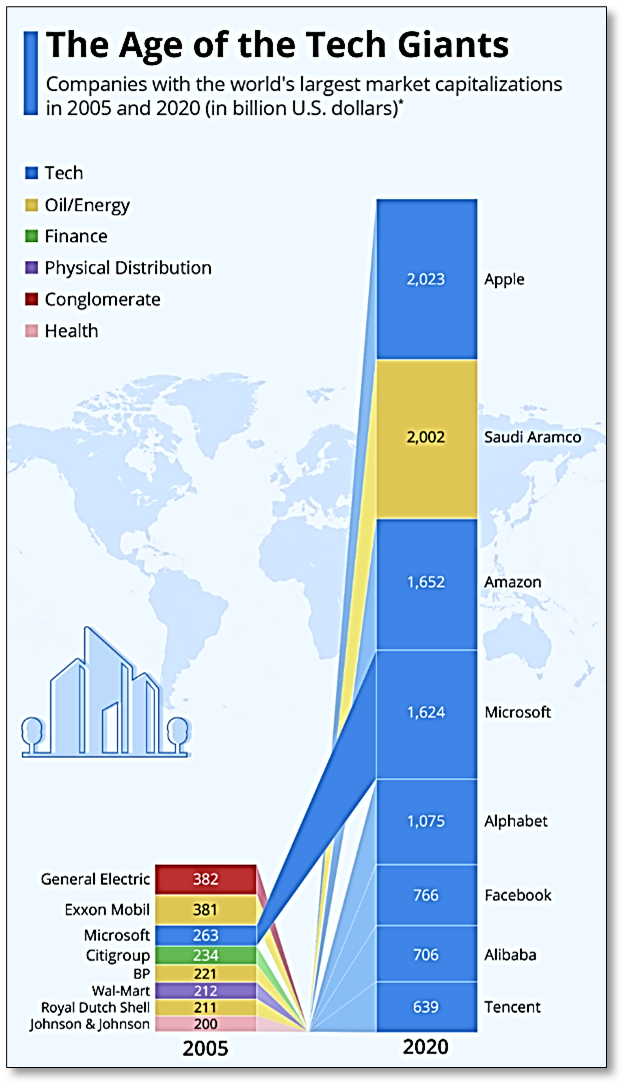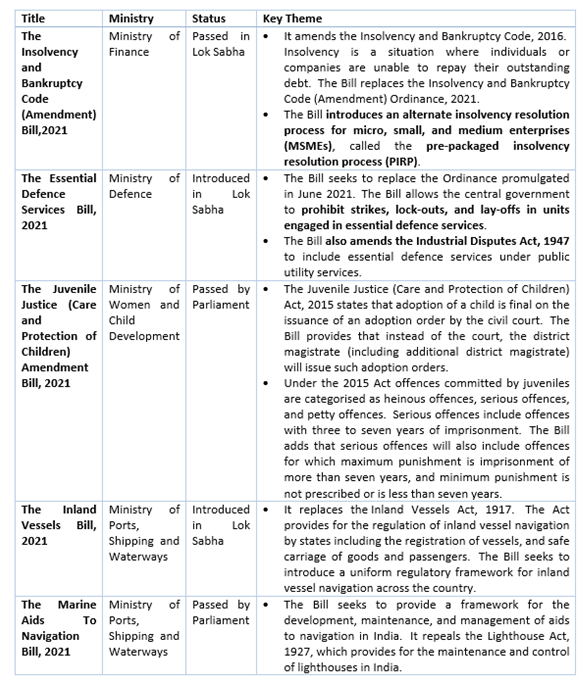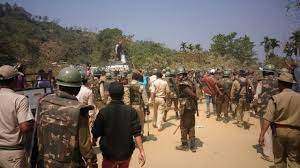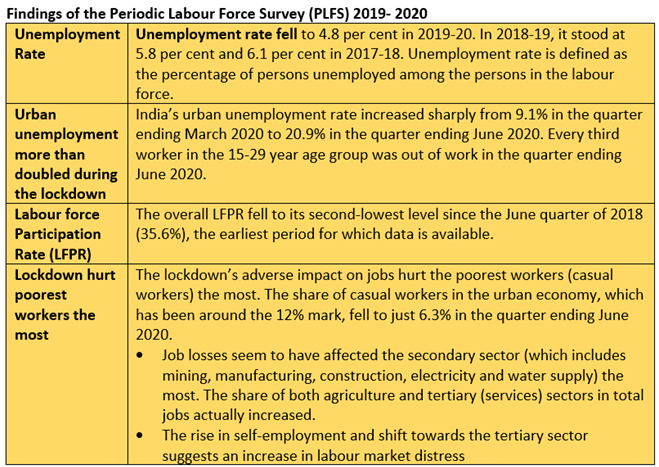Monday, 2nd August 2021
e-RUPI
In News
A digital payment platform called e-RUPI will be launched on August 2, 2021.
About e-RUPI
- The Developers: The platform has been developed by the National Payments Corporation of India in collaboration with the Department of Financial Services, Ministry of Health & Family Welfare and National Health Authority.
- Working of e-RUPI: e-RUPI is a cashless and contactless digital payment medium, which will be delivered to mobile phones of beneficiaries in form of an SMS-string or a QR code. This will essentially be like a prepaid gift-voucher that will be redeemable at specific accepting centres without any credit or debit card, a mobile app or internet banking.
- e-RUPI connects the sponsors of the services with the beneficiaries and service providers in a digital manner without any physical interface. It also ensures that the payment to the service provider is made only after the transaction is completed. Being pre-paid in nature, it assures timely payment to the service provider without involvement of any intermediary.
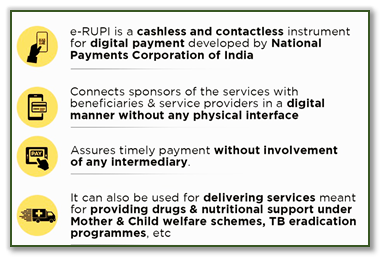
- Issuing of Vouchers: The system has been built by NPCI on its UPI platform and has onboarded banks that will be the issuing entities. Any corporate or government agency will have to approach the partner banks, which are both private and public-sector lenders, with the details of specific persons and the purpose for which payments have to be made.
- The beneficiaries will be identified using their mobile number and a voucher allocated by a bank to the service provider in the name of a given person would only be delivered to that person.
- Connect to government schemes: It can be used for delivering services under schemes meant for providing drugs and nutritional support under Mother and Child welfare schemes, TB eradication programmes, drugs and diagnostics under schemes like Ayushman Bharat Pradhan Mantri Jan Arogya Yojana besides fertilizer subsidies.
- Even the private sector can leverage these digital vouchers as part of their employee welfare and corporate social responsibility
- Significance: The government is already working on developing a central bank digital currency and the launch of e-RUPI could potentially highlight the gaps in digital payments infrastructure that will be necessary for the success of the future digital currency. In effect, e-RUPI is still backed by the existing Indian rupee as the underlying asset and specificity of its purpose makes it different to a virtual currency and puts it closer to a voucher-based payment system.
- The person who is buying the vouchers and issuing them to others can track the utilisation of the vouchers. The concept of electronic voucher takes forward this vision of Good Governance. Privacy concerns have also been addressed as the beneficiaries won't have to share their personal details.
Sources:
Academic Bank of Credit (ABC)
In News
The University Grants Commission (UGC) recently notified the Academic Bank of Credits (ABC), an academic service mechanism for storing and transferring of academic credits of a student.
About the News
- Part of NEP: One of the provisions of the National Education Policy 2020 (NEP 2020) is the introduction of the Academic Bank of Credit (ABC). ABC will allow students of undergraduate and postgraduate degree courses to exit the course and enter within a stipulated period.
- Academic Bank Account: Academic Bank of Credits shall deposit Credits awarded by Registered Higher Education Institutions, for Courses pursued therein, in the Academic Bank Account of the student and the validity of such credits shall be as per norms and guidelines issued by the Commission from time to time.
- ABC shall not accept any document pertaining to course credits directly from students and shall entertain such documents as valid only when the same are transmitted by the respective Registered Higher Education Institution(HEIs) awarding the credits.
- Student ID and SOP: Academic Bank of Credits shall provide to every student the facility to open unique or individual Academic Bank Account in digital form; and the account holder shall be provided with a unique ID and access to the Standard Operating Procedure (SOP).
- Blended Learning: The ABC Regulations intend to give impetus to blended learning Mode, allowing students to earn credits from various HEIs registered under this scheme and through SWAYAM, an online repository of courses. The student can earn up to 50 per cent credits from outside the college/university where she/he is enrolled for the degree/diploma programme.
- Courses undergone by the students through the online modes through National Schemes like SWAYAM, NPTEL, V-Lab or of any specified university, shall also be considered for credit transfer and credit accumulation.
- Accrual and Redemption: Credits obtained by students by undergoing Skill-courses from Registered Higher Education Institutions offering vocational Degree or Diploma or Post Graduate Diploma or Certificate programmes are also eligible for accrual and redemption of credits through the Academic Bank of Credits.
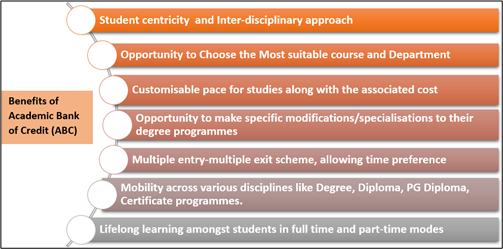
Concerns regarding Academic Bank of Credit
Delhi University Teachers' Association (DUTA) are concerned that in their total advocacy of online/virtual solutions, the ABC overlooks the following:
- The digital divide of - access (class, caste, gender, region, rural/urban), and affordability (cost for the poor);
- The dilution of rigor and intensity of courses; and
- Impact on working conditions of teachers with fluctuating workload which will lead to loss of employment and casualisation/contractualisation.
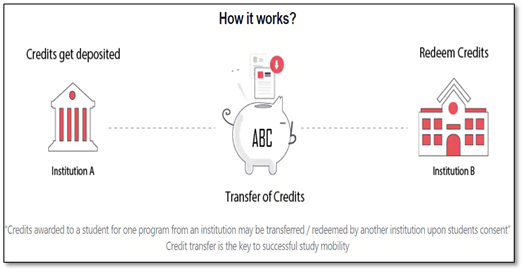
Sources:
No Parliamentary Immunity for Vandalism: SC
In News: The Supreme Court has rejected Kerala government’s plea to withdraw criminal cases against its MLAs who destroyed public property and disrupted a Budget speech on the State Assembly floor in 2015 and were charged in the assembly.
Claim of the Kerala Government
- The Kerala Government had claimed parliamentary privilege, arguing that the incident occurred inside the assembly hall.
- The Government also claimed immunity from criminal prosecution and argued that the prior sanction of the Speaker was necessary before the registration of an FIR by the police.
Highlights of the Recent Judgement
- The apex court ruled that Parliamentary Privileges are not gateways of immunity and hencethe legislators who indulge in vandalism and general mayhem cannot claim parliamentary privilege and immunity from criminal prosecution.
- The court opined that lawmakers possess privileges that are essential for exercising public functions and that vandalism is not an essential legislative action.
- It added that Vandalism on the Assembly floorcould not be equated with the right to protest or freedom of speech by opposition legislators.
- Legislators should act within the parameters of the public trust imposed on them to do their duty as they have taken office swearing true allegiance to the Constitution.
- They had to uphold the sovereignty and integrity of India and had to perform the duty imposed on them by the people who elected them.
What are Parliamentary Privileges?
- Parliamentary privileges are certain rights and immunities enjoyed by members of Parliament, individually and collectively, so that they can “effectively discharge their functions”.
- Article 105 and Article 194 of the Constitution mentions freedom of speech in Parliament and right of publication of its proceedings as the two privileges of the members of both the Parliament and the State Assemblies.
- Rule No 222 in Chapter 20 of the Lok Sabha Rule Book and Rule 187 in Chapter 16 of the Rajya Sabha rulebook govern the privilege.
Source:
Domestic Firms and FTAs
In News
India and the EU are likely to begin negotiations on the revamped proposal for a bilateral free trade agreement (FTA) in September, as India wants to get into trade pacts with countries that are outside the influence of China.
What are Free Trade Agreements (FTAs)?
- FTAs are arrangements between two or more countries or trading blocs that primarily agree to reduce or eliminate customs tariff and non-tariff barriers on substantial trade between them. FTAs, normally cover trade in goods (such as agricultural or industrial products) or trade in services (such as banking, construction, trading etc.). FTAs can also cover other areas such as intellectual property rights (IPRs), investment, government procurement and competition policy.
- India has 43 bilateral or plurilateral FTAs, including those under negotiation. Most are with regional partners: The South Asia Free Trade Agreement (SAFTA), India-ASEAN Comprehensive Economic Cooperation Agreement (CECA), India-Korea Comprehensive Economic Partnership Agreement (CEPA) and the India-Japan CEPA.
- India has benefited overall from the free-trade agreements (FTAs) signed with its trade partners from the perspective of trade balance. However, some trade experts point out that the benefits mostly accrue with respect to trade partners who are small in size and suffer from supply constraints, while India’s trade deficit is increasing with most major partners.
What has been the Impact of FTAs on Indian Firms?
India’s experience with FTAs has not gone to script, especially for its exports. While it has managed to expand its export offerings and access new markets, the general opinion is that trading partners have benefited more from FTAs with India. The problem areas:
- Domestic MSME sector: Since India’s FTA outreach has been broadly limited to its neighbours, it has come at an enormous cost to domestic businesses. Most of our FTA partner-countries, like Bangladesh, are competing with us globally in similar product categories. This hurts domestic firms, particularly the MSME sector, which accounts for over 40% of the country’s exports.
- Labour- intensive sectors: Apart from India, the other SAARC countries like Bangladesh, Sri Lanka and Pakistan are leading exporters of garments and textiles and are home to many manufacturing hotspots specialising in labour-intensive segments. In fact, imports from Bangladesh are severely hurting the domestic garment industry.
- White Goods industry: Indian white goods manufacturers cannot practically export to the ASEAN region because that is already a very competitive market, flooded with cheaper electronic products due to machinery and electronics supply from China to SAARC countries.
- Duty Disadvantage: India has a duty disadvantage of 9.6% in the EU as compared with Bangladesh, Turkey, Cambodia, Pakistan, and Sri Lanka — all of which enjoy zero duty. The EU’s imports from India have declined 5% from 2016 to 2020. But it has increased by 3% from Bangladesh, 2% from Turkey, etc.
- Plastics Sector: The sector is home to thousands of exporting firms, whose growth is also being stifled by the ramifications of several issues in the ASEAN and SAARC FTAs. Under the India-ASEAN pact, for example, PVC flooring from Vietnam is eligible for a preferential 5% import duty as against a 15% basic customs duty. However, when the same product is exported to Vietnam, it attracts 27% import duty, against NIL duty on Chinese and Thailand PVC flooring. Indian PVC flooring does not get preferential tariffs in Indonesia, Malaysia, and Thailand either.
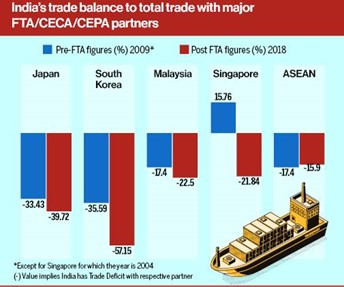
Why have India’s FTAs not reached its potentials?
- Low Utilization of FTAs: The utilization rate of India’s FTAs is very low. Lack of information on FTAs, low margins of preference, delays and administrative costs associated with rules of origin, non-tariff measures, are major reasons for underutilization.
- Circumvention of FTAs: Data suggests significant indirect inflow of Chinese goods and investments through locations with which India has free trade agreements (FTAs), preferential trade agreements (PTAs) or other bilateral commercial arrangements. This is not only illegal but also injuring domestic industry.
- Non-Tariff Barrier: These barriers include differences over packaging and labelling requirements, the absence of mutual recognition of certificates, complicated trade financing and inadequate modernisation of procedures.
- Zero-for-zero agreements: ASEAN, South Korea and Japan have FTAs with many more countries than we do, including China. Some of these are the so-called zero-for-zero agreements, where zero items are excluded from the FTA and a zero tariff applies in both directions. This enables close supply-chains to develop and prosper. By excluding items from our agreements, we limit the extent of the market and our ability to participate in these supply-chains.
- Spaghetti Bowl Effect: It is an interesting phenomenon in trade economics where the increasing number of Free Trade Agreements (FTAs) between countries slows down trade relations between them. Too many crisscrossing FTAs allow countries to adopt discriminatory trade policies and reduce the economic benefits of trade.
- Infrastructure problems: A sizable part of manufacturing in the country suffers from infrastructure inadequacies and high logistics costs.
What can be done to make the FTA’s work in India’s favour?
- Favourable Ecosystem: In general, an FTA, by changing the rule of the existing trade regime, may increase the transaction cost of trading unless complementarity steps are taken so that the ecosystem of trading doesn’t turn out to be inefficient due to additional complexity.
- Diversification of partner countries: India should explore new markets by forging FTAs in Africa, Latin America, and the Commonwealth of Independent States (CIS). Countries like Nigeria and South Africa feature on the list of India’s top 25 export destinations but we don’t have any trade agreements with them.
- Atmanirbhar Bharat as part of FTAs: Atmanirbhar Bharat’s agenda should be a part of the FTA methodology so that India’s production possibilities are enhanced. The focus of the FTAs must be to connect with global value chains to place our products better in front of global buyers.
- Services in FTAs: Services and goods should get equal focus during negotiations, especially as India has an enormous advantage in sectors such as IT & ITES and R&D, among others. The flexibility of free movement of professionals should be a part of FTAs.
- Consideration of Stakeholders: Before getting into any multilateral trade deal India should review and assess its existing FTAs in terms of benefits to various stakeholders like industry and consumers, trade complementarities and changing trade patterns in the past decade.
- Strengthening Rules of Origin: Customs (Administration of Rules of Origin under Trade Agreements) Rules, 2020 (CAROTAR 2020) have been introduced to address long-standing infractions relating to import of goods under Preferential Trade Agreements (PTA).
- The CAROTAR provides the minimum basic information that the importer needs to know before importing goods. These rules help the importer to ascertain the country of origin, assist Customs Authorities in the smooth clearance of import of goods under FTAs and claim concessional duty.
Conclusion: Since the 1990s, trade agreements have allowed India to compete on a global scale, be part of the global value chain and meet its economic growth targets. Despite fully embracing trade agreements, India’s experience with FTAs has been bitter-sweet, especially for its exporting community. While these deals have helped it expand its export basket, the majority of India’s FTAs have proved more beneficial to its trading partners. Given that trade agreements will remain relevant in the years to come, India must work on its FTA strategy.
Question: Discuss the impacts of FTAs on Indian Domestic Firms and the reasons for these impacts. What are the steps needed to make FTAs work in India’s favour?
Sources:
- Free Trade Agreements
- India’s free trade agreements are ‘hurting domestic firms’. Here’s the formula to make FTAs work
- A NOTE ON FREE TRADE AGREEMENTS AND THEIR COSTS*
- What ails India’s Free Trade Agreements?
- India's FTAs: Threat or opportunity?
- India-EU FTA talks likely in September but no resolution yet on linking of investments, GIs
- Why India should not ignore RCEP free trade mega deal
This Day in History - Pingali Venkayya
On August 2, 1876, Pingali Venkayya was born. He was an Indian freedom fighter who the nation remembers proudly for reasons more than his struggle for our independence. It was his design on which India's national flag was based upon. Born near Machilipatnam (now in Andhra Pradesh), Venkayya was a Gandhian ideologist.
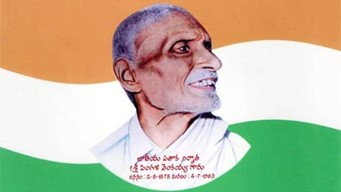
Source:
Image of the Day - Neelakurinji
This is the image of Strobilanthes Kunthiana, known as Neelakurinji/Kurinji in South India. Idukki's Shalomkunnu (Shalom hills) are currently blossoming with the blue Neelakurinji flowers, which blooms once every 12 years. It is a shrub that is found in the Shola forests of the Western Ghats in Kerala and Tamil Nadu. The Nilgiris Hills, which means "blue mountains", got its name from these Neelankurinji flowers.

Source:
Biotech-PRIDE
- Context: The Department of Biotechnology (DBT), Ministry of Science and Technology has released Biotech-PRIDE (Promotion of Research and Innovation through Data Exchange)
- To promote India’s own exclusive biological research and solutions database, Indian Biological Data Centre (IBDC) will be created.
- The guidelines aim to bridge existing datasets/ data centres to this IBDC which will be called Bio-Grid.
- This Bio-Grid will be a National Repository for biological knowledge, information and data and will be responsible for enabling its exchange, developing measures for safety, standards and quality for datasets and establishing detailed modalities for accessing data.
- Currently, India ranks number 4 amongst the top 20 countries contributing biological databases.
Source:
Near-surface shear layer (NSSL) of the Sun
- Context: Indian astronomersfrom Aryabhatta Research Institute of Observational Sciences (ARIES), and Indian Institute of Science, Bangalore, have for the first time given the theoretical explanation of the existence of a near-surface shear layer (NSSL) in the Sun.
- NSSL is the region that exists very close to the solar surface, where the rotation profile of the Sun changes sharply and where there is an outward decrease in angular velocity.
- Understanding NSSL is crucial for the study of solar phenomena like sunspot formation, solar cycle and such phenomena in other stars.

Source:
- Intriguing layer where internal rotation profile of Sun changes theoretically explained
- 'Intriguing' layer where sun's internal rotation change explained
Image source:
CRISIL’s Deficient Rainfall Impact Parameter (DRIP)
- Context: The rainfall pattern has become skewed, with some regions continuing to face deficiency while others staring at deficit earlier are now grappling with excess thus affecting agriculture.
- DRIP index (developed in 2002) is an effective gauge of the impact of deficient monsoon on agriculture.
- The higher the CRISIL DRIP score, the more adverse the impact of deficient rains.
- DRIP is a better indicator than percentage deviation of rainfall from normal as it captures both shock (deviation from normal) as well as vulnerability of a region (measured as percentage of un-irrigated area).
- Latest DRIP scores show some stress in West Bengal, Andhra Pradesh, Tamil Nadu and Haryana – where delayed or still-absent rains have created pain.
Source:
Chempaka Raman Pillai
- Context: The slogan 'Jai Hind' was coined by Chempaka Raman Pillai - a Tamil freedom fighter from Thiruvananthapuram, Kerala.
- Pillai formed a group of international pro-Indians in Switzerland, which had taken a neutral stance during the First World War.
- In 1914, Raman Pillai formed the Indian National Voluntary Corps and urged war on British India.
- He called on all Indians, especially Muslims and Sikhs, to fight for India and sent emissaries to Japan and China to forge alliances.
- Pillai started a military camp in Mesopotamia and formed a provisional government in Kabul to look after Indian affairs.
- He directed an exhibition of Indian products in Germany in 1924.
- In 1930, he became the Berlin representative of the Indian Chamber of Commerce.

Source:
RBI’s role in mitigating climate risks’ impact- HBL
Essence: Climate change poses risk to stability of financial system of India (termed as ‘green swan risks’) in two ways i.e., physical risks and transition risks. Here, central banks have emerged as important players in the prevention and mitigation of climate change-related impacts on the economy and financial system. Critics have argued that the RBI has been relatively slow in its progress. But in recent times, RBI took various steps to identify, assess and mitigate the impact of climate change. Nevertheless, there is scope for the RBI and financial regulators in India to do even more and require a more proactive role to be played in both facilitating green finance and mitigating the impact of climate-related financial risks.
Why should you read this article?
- To understand the impact of climate change on economy and financial stability of India.
- To understand how Central bank may play a significant role in mitigating these impacts.
- To know steps taken by RBI in recent past.
Source:
How to get the next set of reforms right- HT
The article provides input into the next generation reforms required for national development. It prioritizes tax, labor, financial sector, power-sector, land and agricultural reforms to begin with. The discussion cautions the government of the complex nature of these reforms, and asks the government to pay attention to details and the spirit of democracy which must act as the foundation of these reforms.
Why you should read this article?
- To understand the important sectors for 2nd generation reforms.
- To orient oneself into the intricacies of method to be utilized in various sectors of economy.
Source:
Apology: To accept or not?
A small brief
- New Zealand government expressed ‘sorrow, remorse and regret’ over historic immigration crackdowns targeting Pacific communities.
- Police crackdowns in the 1970s had targeted the country’s Pacific communities under the infamous “Dawn Raids”, during which police – often accompanied by dogs – raided homes to find overstayers who were then convicted and deported.
Why the apologise now?
- Trust deficit: The incidences have been etched in the memory of those who were directly impacted leading to disruption of trust and faith in authorities.
- Victim mentality: Communities who suffered have developed a victim mentality leading to loss of social capital.
- Correct the wrong doings: inhumane and unjust treatment.
Why does apology signify?
- Honesty, Remorse, Care, Conscience, Courage to accept mistake
Quote
- The weak can never forgive. Forgiveness is the attribute of the strong.
Source:
Share the article
Get Latest Updates on Offers, Event dates, and free Mentorship sessions.

Get in touch with our Expert Academic Counsellors 👋
FAQs
UPSC Daily Current Affairs focuses on learning current events on a daily basis. An aspirant needs to study regular and updated information about current events, news, and relevant topics that are important for UPSC aspirants. It covers national and international affairs, government policies, socio-economic issues, science and technology advancements, and more.
UPSC Daily Current Affairs provides aspirants with a concise and comprehensive overview of the latest happenings and developments across various fields. It helps aspirants stay updated with current affairs and provides them with valuable insights and analysis, which are essential for answering questions in the UPSC examinations. It enhances their knowledge, analytical skills, and ability to connect current affairs with the UPSC syllabus.
UPSC Daily Current Affairs covers a wide range of topics, including politics, economics, science and technology, environment, social issues, governance, international relations, and more. It offers news summaries, in-depth analyses, editorials, opinion pieces, and relevant study materials. It also provides practice questions and quizzes to help aspirants test their understanding of current affairs.
Edukemy's UPSC Daily Current Affairs can be accessed through:
- UPSC Daily Current Affairs can be accessed through Current Affairs tab at the top of the Main Page of Edukemy.
- Edukemy Mobile app: The Daily Current Affairs can also be access through Edukemy Mobile App.
- Social media: Follow Edukemy’s official social media accounts or pages that provide UPSC Daily Current Affairs updates, including Facebook, Twitter, or Telegram channels.

